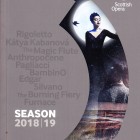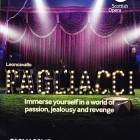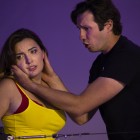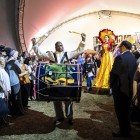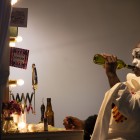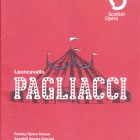Pagliacci 2018Scottish Opera
Read more about the opera Pagliacci
Scottish Opera's 2018/19 season started earlier than usual, in July, with the company's first full-scale staging of one of the most popular works of the verismo school. Leoncavallo's Pagliacci. It was mounted in Paisley in an impressively large-scale production with many local performers, all in a temporarily-erected marquee structure, able to contain with ease several performing areas, a platform for the orchestra, bar and café sections and room for sideshows, still leaving plenty of space for a sold-out audience of four hundred to promenade around the interior following the action with ease.
Scottish Opera's experience with this excellent dramatic tragedy is surprisingly limited, given the work's near-universal popularity in operatic circles. A medium-scale touring production with young singers was put on in the autumn of 1989, without being seen in the major centres. Much later, the company's fiftieth anniversary in 2012 was celebrated by a concert performance in Glasgow's City Halls with an excellent international cast. Both these productions saw Leoncavallo's masterpiece played in the usual theatre partnership with Mascagni's Cavalleria rusticana. Now, for once, Pagliacci could be seen alone, making redoubled impact, which was not at all diminished by placing an interval between the two acts.
This interesting summertime experiment was supported by Renfrewshire Council and Renfrewshire Leisure. An excellent professional cast joined Scottish Opera's conductor and orchestra and a chorus made up of a blend of professionals - the company's regular freelance chorus - with enthusiastic and talented amateurs from the local community. In all there was a chorus of more than ninety, including fifteen children. This approach seems modelled on the hugely successful style of presentation developed in recent years by Graham Vick with Birmingham City Opera - Stuart Stratford actually worked there himself.
The performances took place in a huge tented structure at the Seedhill Sports Ground, instantly dubbed 'Paisley Opera House', which sounded rather like the massive marquee erected in London at Holland Park, where Stuart Stratford has already conducted a thrilling range of verismo pieces, including Pagliacci. However the major departure was that it was essentially a promenade-style performance, with most audience members on their feet for the duration - in amongst the action for an hour and a half. The impact of the entrance of the clowns, followed by the procession of amateur choristers, was redoubled by having the professional singers mingling with the audience. Any potential issues of musical co-ordination were tactfully taken care of - a couple of peripatetic conductors in the crowd helped out where the monitors of Stuart Stratford were not visible.
Director Bill Bankes-Jones always seems to manage to bring a fresh eye to a well known work. However he can also be happy to retain familiar ingredients such as the traditional Italian commedia dell'arte background for this piece, while still taking advantage of the open nature of the production. For instance Silvio's presence was justified by making him a member of the company's technical crew, moving in and out of the action at will. Bankes-Jones also provided the new English translation, which sounded well. The last line of the Prologue, usually given as 'Ring up the curtain!' became the more appropriate 'Switch off your mobiles!'
Tim Meacock designed a series of simple, practical performing areas. A long trailer in the centre of the arena provided a platform for the play, as well as ante-rooms for the Prologue and 'Vesti la giubba'. There was a high gantry (visible in the photo below just behind Nedda's parasol) from which Nedda sang her song to the birds followed by the scene with Silvio. The clown costumes were a skilful blend of traditional and modern. All three performances took place in daylight, so the matinee may not have looked very different from the earlier shows. During the second act, what had been a steady, but light, drizzle, suddenly became a torrential downpour, thankfully brief, but the constant extra percussion sounds from above didn't seem to cause any difficulty.
The cast was led by dramatic tenor Ronald Samm as Canio. He sang Otello with Opera North a few seasons ago and has built an excellent reputation. This was a notable company debut in a role that suited him perfectly. Nedda was lyric soprano Anna Patalong, who a couple of years ago sang beautifully as Pamina in The Magic Flute at the Perth Festival. This part requires rather more power in its dramatic moments, but she coped with ease, as she did also with her gantry, which was quite high and far removed from the orchestra,
Dramatic bass-baritone Robert Hayward has appeared with Scottish Opera many times, most recently as Bluebeard. Tonio was a rather different part, vocally higher-lying. His Prologue launched the show in fine style - though with perhaps more vibrato than he showed later. Another experienced trouper was Alasdair Elliott as Beppe, delivering his serenade in a beautifully relaxed style. Rather like Schaunard in La bohème, Silvio is a part that major houses use to try out promising young baritones. At Covent Garden, the part has in the quite recent past been taken by such talented youngsters as Thomas Allen, Jonathan Summers and Simon Keenlyside. Samuel Dale Johnson has already been seen here in more obviously 'star' characterisations, Almaviva and Onegin, and it was good to see him 'stepping down' here. He was more prominent than usual taking part in the action, trotting round the arena making his way through the spectators as the drama developed - and, of course, his singing was excellent.
There was a very limited amount of seating available for audience members with restricted mobility in a gantry adjacent to the orchestra, but this appeared to be carefully placed to give generally good sightlines. The tables at café and bar were also available during the show, but were probably less useful in that respect. For an hour before the performance there was a range of appropriate games and entertainments including a Punch and Judy show and fortune teller. There was a further highlight as the orchestra was put through its paces with the challenge of following the beat of several amateurs (supposedly competition winners) including a highly talented toddler (Nedda's child, with a little help from Dad) and the Australian technician-cum-baritone. Great fun for all.
This really was an excellent event, a new departure for the company which it should be able to develop in future years. This Pagliacci could be revived at other venues with similar groups of participants and sponsors - not just as a summer show under canvas, but in other seasons at suitable big indoor spaces too. And there are no doubt many other operas that could be given similar treatment.
Performance Cast
- Tonio a player
- Canio leader of the players
- Nedda Canio's wife
- Beppe a player
- Silvio a villager
- First Villager
- Second Villager
